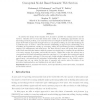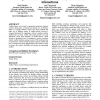396 search results - page 29 / 80 » How scientific models can explain |
ER
2005
Springer
14 years 1 months ago
2005
Springer
To achieve the dream of the semantic web, it must be possible for ordinary users to invoke services. Exactly how to turn this dream into reality is a challenging opportunity and a...
FPLAY
2008
13 years 9 months ago
2008
Conflict theory can be used to explain the interactions between societies during times of turmoil and change (i.e. revolutions, strikes or everyday debates). Games have been produ...
BVAI
2007
Springer
13 years 11 months ago
2007
Springer
Many think attention needs an executive to allocate resources. Although the cortex exhibits substantial plasticity, dynamic allocation of neurons seems outside its capability. Supp...
ICALT
2006
IEEE
14 years 1 months ago
2006
IEEE
Observation activity, on instrumented collective learning situations, enables participants to appropriate themselves corresponding systems in their own practice. In this paper, we...
LPNMR
2005
Springer
14 years 1 months ago
2005
Springer
We describe an application of Abductive Logic Programming (ALP) to the analysis of an important class of DNA microarray experiments. We develop an ALP theory that provides a simple...


